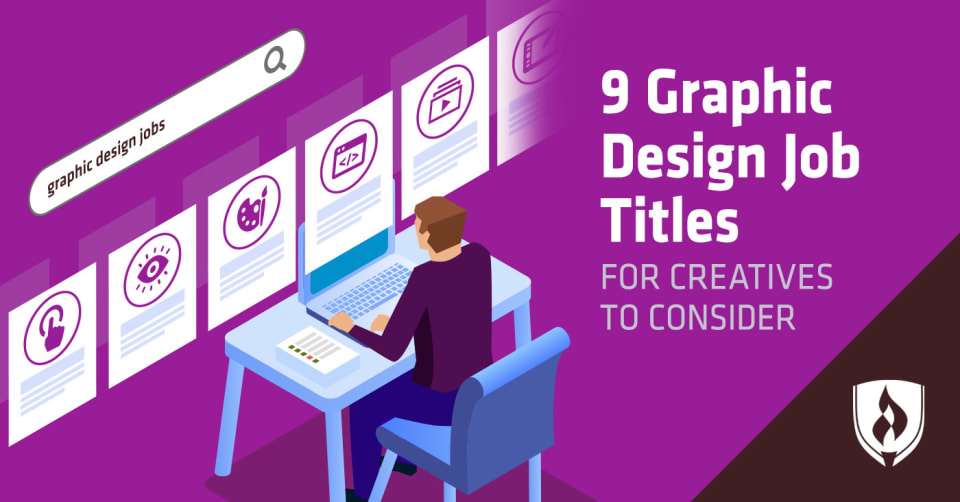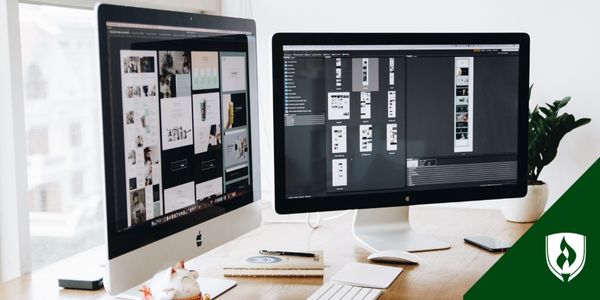
Maybe the margins of your notebooks are filled with doodles, geometric shapes or sketches of things around you. Maybe your hand has always itched to grab hold of a paintbrush or a bit of charcoal. Or maybe you simply look at the world a little differently—noticing the aesthetics of the city’s architecture while you wait for a bus, or a bold color palate in a storefront window.
Whatever the details, a career in graphic design has always appealed to you. As you consider how to approach planning for a career that utilizes your creative potential, take a moment to explore the vast array of job titles within the field of graphic design.
Creative output takes on a lot of forms, so it’s no wonder there’s a good variety of job roles that can fall under the umbrella of graphic design. Whether you want to design products, web content, or manage the big picture, there are many options open for you to explore. We have identified several job titles for graphic designers that represent some of the exciting and dynamic approaches to a career in graphic design.
9 Job titles that will put your graphic design skills to use
Depending on how you approach being a graphic designer, you could be working for a marketing agency, as part of an in-house team for a large company, or as an independent contractor. Graphic designers work to develop and refine visual communication. Through illustration, graphics and typography, graphic designers communicate ideas and messages.
Visual communication is essential across industries and fields. Graphic designers might find themselves working in many different and creative capacities ranging from the very technical to the very abstract. Depending on your interests and skills, you might be suited for a number of surprising roles within graphic design. Here are nine job titles that bring graphic designers to a diverse group of job settings.
1. Production artist
Production artists were once responsible for what was known as “paste-up work,” literally cutting and pasting layouts before designs were printed. Today, production artists work with computer programs to finalize the quality of designs and make sure everything meets the appropriate standards for file formatting or printing requirements. Production artists need a strong understanding of design software—often they’re tasked with taking an overall design layout and adjusting in order to fit specific digital and print formats or specifications.
Want to learn more about the work of a production artist? Our article, “What Is a Production Artist? The Experts in Creative Execution,” goes into further detail.
2. UX designer
A UX designer, or “User Experience Designer,” focuses on how individuals experience and interact with products, apps or websites. This design specialty keeps user needs and the overall purpose of a design at the top of mind by incorporating accessibility factors and user psychology into the overall look and feel of a design. This design focus area is often “hidden”—most people don’t notice good UX design because it often just feels right; buttons are in places that make sense, information flows intuitively and the user’s eye is naturally drawn to the most important areas of the design.
3. Multimedia designer
Multimedia designers work across two or more forms of content. You can think about multimedia designers as a contrast to the iconic advertisers working on Madison Avenue in the 1960s who worked only in print and still images. Multimedia designers might work with text, audio, images, animations, video or interactive content. Their technical skillset as well as their creative imagination is valued in fields as diverse as gaming and entertainment, telecommunications and even the fine arts.
4. Animator
Animators create films and visual effects by sequencing images, drawings or models to bring their designs to life. Animators typically work for production companies, computer game companies or animation studios. While not common, some animators are even employed to recreate crime scenes or other locations for forensic experts.
To read more about where animators work take a look at, “Where Do Animators Work: 5 Options You Never Knew Existed.”
5. Art director
Art directors typically manage a team of artists, working more with people than with creating layouts. Though art directors don’t typically create individual components of a book cover, magazine spread or advertising campaign, they are responsible for creating the overall visual concept. They work closely with copywriters to create a cohesion between graphics and text so that each design has a strong, clear impact. As managers, art directors need strong leadership skills and an interest in fostering the strengths of each member of their team.
6. Layout artist
Layout artists work with software such as InDesign or PageMaker to put together images in a larger design. Layout artists rely on strong artistic skills to balance compositions and communicate ideas. Some layout artists may be responsible for creating the concept of their layout as well as the execution, while others are responsible for putting together an existing design concept.
7. Web developer
Graphic designers frequently transition into web design. Though it requires additional knowledge of coding and software programs, much of web development comes down to visual communication—the expertise of graphic designers. Web developers need to understand user interface, much like UX designers. As many web developers are self-employed, strong organizational and interpersonal skills are highly advantageous.
8. Book designer
Book designers develop both exterior covers and interior layouts of books. Creating the interior of books is called typesetting, though instead of putting together each letter of type on a printing press, modern book designers rely on software programs such as InDesign or Quark. Designing book covers might involve creating illustrations or putting together unique and eye catching fonts. Strong book designers are able to reflect the content, tone and voice of a book with a single graphic—no easy feat.
9. Teacher (non-licensed roles)
Graphic design is an ever-changing, nuanced profession. To prepare the next generation of graphic designers, colleges, universities and training programs need teachers with experience, insight and an interest in helping new people enter the world of graphic design. While the work of graphic designers is often to create the next great design, a graphic design teacher is more interested in helping to support the next great designer. For designers that find themselves more interested in the human side of design, teaching can become a fulfilling role.
Interested in learning more about graphic design?
If you are interested in graphic design, there are a lot of opportunities available to you. Take time to explore your options and interests within the field. Though a career in graphic design can be exciting and lucrative, it is also a competitive and fast paced field. Prospective graphic designers may choose to explore the field on their own or enter a graphic design degree program, take the next step in planning your career by asking, “Is a Graphic Design Degree Worth It or Worthless?. Additionally, check out our article with everything you need to know about digital design.
Related Articles:
- What Is a Production Artist? The Experts in Creative Execution
- What Do Graphic Designers Do? A Closer Look at this Creative Career
- 8 Reasons Moms Make Great Graphic Designers
- 6 Overlooked Qualities of a Standout Graphic Designer
- 13 Things Every Web Designer Needs to Know About SEO
- 5 Graphic Design Courses to Get Excited About




